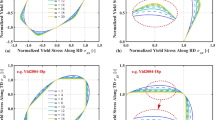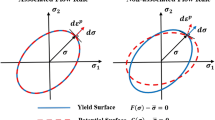Abstract
Recently developed anisotropic yield functions can capture the material anisotropic behaviors through parameter optimization. However, sometimes the parameter optimization is not easy and does not always have a unique solution. This paper introduces an anisotropic yield function that does not require the parameter calibration process. This model simplifies the coupled quadratic and non-quadratic yield function in order to directly use the measured on-set of yielding stress and r-value data without the calibration process. The presented model is validated with five different materials for the prediction of stress and strain anisotropies. In addition, a cup drawing simulation is also presented to validate the simplified model in a practical metal forming simulation with the User-defined subroutine of ABAQUS. The results of this paper show that the simplified model can be effectively employed for the simulation of sheet metal forming processes.









Similar content being viewed by others
References
Hill, R. (1948). A theory of the yielding and plastic flow of anisotropic metals. Proc. R. Soc. Lond, A, 193, 281–297.
Hosford, W. F. (1972). A generalized isotropic yield criterion. J. Appl. Mech. Trans, 39(2), 607–609.
Hill, R. (1972). Constitutive analysis of elastic-plastic crystals at arbitrary strain. Journal of the Mechanics and Physics of Solids, 20(6), 401–413.
Hill, R. (1990). Constitutive modelling of orthotropic plasticity in sheet metals. Journal of the Mechanics and Physics of Solids, 38(3), 405–417.
Hosford, W.F. (1979). On yield loci of anisotropic cubic metals. In: Proc. 7th North American Metalworking Conf. SME, Dearborn, MI.
Logan, R. W., & Hosford, W. F. (1980). Upper-bound anisotropic yield locus calculations assuming< 111>-pencil glide. International Journal of Mechanical Sciences, 22(7), 419–430.
Barlat, F., & Lian, J. (1989). Plastic behavior and stretchability of sheet metals. Part I: A yield function for orthotropic sheets under plane stress conditions. Int. J. Plasticity, 5, 51–66.
Barlat, F., Lege, D. J., & Brem, J. C. (1991). A six-component yield function for anisotropic materials. Int. J. Plas, 7(7), 693–712.
Chung, K., & Shah, K. (1992). Finite element simulation of sheet metal forming for planar anisotropic metals. International Journal of Plasticity, 8(4), 453–476.
Yoon, J. W., Yang, D. Y., Chung, K., & Barlat, F. (1999). A general elasto-plastic finite element formulation based on incremental deformation theory for planar anisotropy and its application to sheet metal forming. International Journal of Plasticity, 15(1), 35–67.
Tong, W. (2016). Generalized fourth-order Hill’s 1979 yield function for modeling sheet metals in plane stress. Acta Mech., 227, 2719–2733.
Szwed, A., Kamińska, I. (2021). Explicit form of yield conditions dual to a class of dissipation potentials dependent on three invariants. Acta Mechanica, 232(3), 1087–1111.
Barlat, F., Brem, J. C., Yoon, J. W., Chung, K., Dick, R. E., Lege, D. J., & Chu, E. (2003). Plane stress yield function for aluminum alloy sheets part 1: Theory. International Journal of Plasticity, 19(9), 1297–1319.
Banabic, D., Aretz, H., Comsa, D. S., & Paraianu, L. (2005). An improved analytical description of orthotropy in metallic sheets. International Journal of Plasticity, 21(3), 493–512.
Banabic, D., Comsa, D. S., Sester, M., Selig, M., Kubli, W., Mattiasson, K., Sigvant, M. (2008). Influence of constitutive equations on the accuracy of prediction in sheet metal forming simulation. In: Numisheet. pp. 37–42.
Cazacu, O., & Barlat, F. (2004). A criterion for description of anisotropy and yield differential effects in pressure-insensitive metals. International Journal of Plasticity, 20(11), 2027–2045.
Stoughton, T. B. (2002). A non-associated flow rule for sheet metal forming. International Journal of Plasticity, 18(5), 687–714.
Stoughton, T. B., & Yoon, J. W. (2004). A pressure-sensitive yield criterion under a non-associated flow rule for sheet metal forming. International Journal of Plasticity, 20(4), 705–731.
Stoughton, T. B., & Yoon, J. W. (2006). A review of Drucker’s postulate and the issue of plastic stability in metal forming. International Journal of Plasticity, 22, 391–433.
Stoughton, T. B., & Yoon, J. W. (2008). On the existence of indeterminate solutions to the equations of motion under non-associated flow. International Journal of Plasticity, 24, 583–613.
Stoughton, T. B., & Yoon, J. W. (2009). Anisotropic hardening and non-associated flow in proportional loading of sheet metals. International Journal of Plasticity, 25, 1777–1817.
Cvitanic, V., Vlak, F., & Lozina, Z. (2008). A finite element formulation based on non-associated plasticity for sheet metal forming. International Journal of Plasticity, 24, 646–687.
Safaei, M., Zang, S., & l., Lee, M.G., Waele, W. D. . (2013). Evaluation of anisotropic constitutive models: Mixed anisotropic hardening and non-associated flow rule approach. International Journal of Mechanical Sciences, 73, 53–68.
Lee, E. H., Stoughton, T. B. Y., & J. W. . (2017). A yield criterion through coupling of quadratic and non-quadratic functions for anisotropic hardening with non-associated flow rule. International Journal of Plasticity, 99, 120–143.
Lee, E. H. (2018). Kinematic hardening model considering directional hardening response. International Journal of Plasticity, 110, 145–165.
Lee, E. H., Choi, H. S., Stoughton, T. B. Y., & J. W. . (2019). Combined anisotropic and distortion hardening to describe directional response with Bauschinger effect. Int. J. Plasticity, 122, 73–88.
Lee, E. H., & Rubin, M. B. (2020). Modeling anisotropic inelastic effects in sheet metal forming using microstructural vectors–Part I: Theory. Int. J. Plast, 134, 102783.
Hollenstein, M., Jabareen, M., Rubin, M.B., (2013). Modeling a smooth elastic–inelastic transition with a strongly objective numerical integrator needing no iteration. Computational Mechanics, 52, 649–667.
Chung, K., Richmond, O. (1992). Ideal forming – I. homogeneous deformation with minimum plastic work. International Journal of Mechanical Sciences, 34(7), 575–591.
Ting, T. C. T. (1985). Determination of C1/2, C -1/2 and more general isotropic tensor functions of C. Journal of Elasticity, 15, 319–323.
Tong, W. (2018). Calibration of a complete homogeneous polynomial yield function of six degrees for modeling orthotropic steel sheets. Acta Mechanica, 229, 2495–2519.
Tian, H., Brownell, B., Baral, M., & Korkolis, Y. P. (2016). Earing in cup-drawing of anisotropic Al-6022-T4 sheets. International Journal of Material Forming, 10(3), 329–343.
Acknowledgements
This work was supported by the Ministry of Trade, Industry & Energy (MOTIE, Korea) through the project (No. 20014530, Development of high-speed impact trimming press for cutting automotive parts of 1.6GPa-class ultra-high strength steel), funded by the Korea Government.
Author information
Authors and Affiliations
Corresponding author
Ethics declarations
Conflict of interest
The authors declare that there are no conflicts of interest.
Additional information
Publisher's Note
Springer Nature remains neutral with regard to jurisdictional claims in published maps and institutional affiliations.
Rights and permissions
About this article
Cite this article
Lim, JH., Lee, EH. A Simplified Anisotropic Yield Function not Requiring Parameter Optimization for Sheet Metals. Int. J. Precis. Eng. Manuf. 23, 67–78 (2022). https://doi.org/10.1007/s12541-021-00579-x
Received:
Revised:
Accepted:
Published:
Issue Date:
DOI: https://doi.org/10.1007/s12541-021-00579-x




